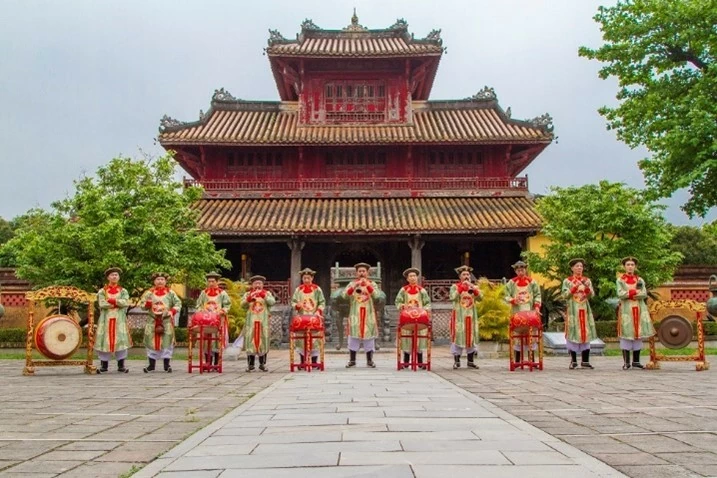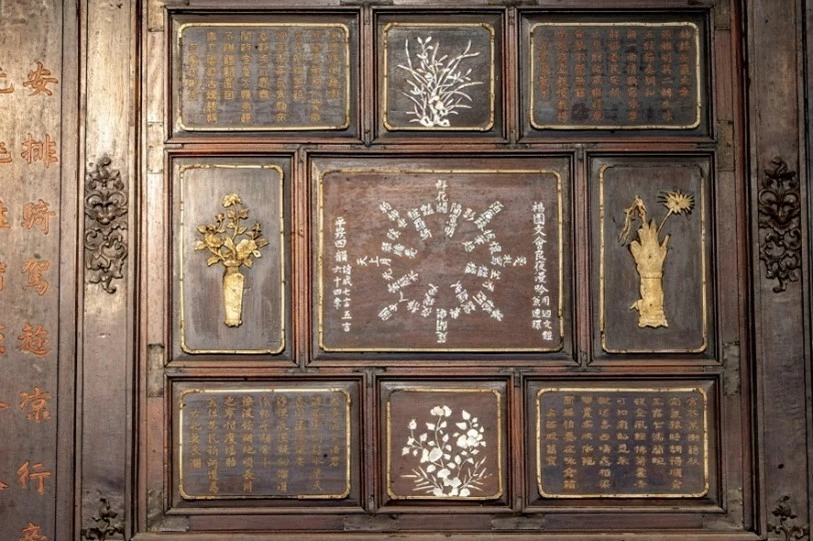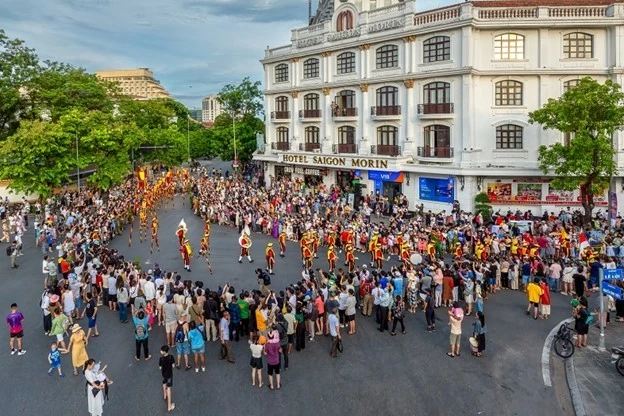
Promoting heritage values to make Hue an attractive destination
Latest
Historically, Hue was once the cultural and political center of Dang Trong region under the Nguyen Lords (1558 - 1777), and during the Tay Son dynasty (1778 - 1802). In the following period, Hue was the capital of the reunified Vietnam (1802 - 1945), not only holding the position as the political center but also the center of culture and religion of Vietnam under the Nguyen dynasty.
The inheritance of the distinctive values of Indigenous culture combined with the essence of the royal dynasties' cultures in history and the new values formed during the Nguyen dynasty has crystallized within the citadel of Hue an immense complex of cultural and historical heritage including both tangible and intangible heritages as well as documentary heritages recognized by the United Nations Educational, Scientific and Cultural Organization (UNESCO).
The land of heritages
So far, Hue owns many types of heritage recognized by UNESCO: The Complex of Hue Monuments (11/12/1993 - World Cultural Heritage); Nha nhac, Court music of Vietnam (7/11/2023 - Intangible Cultural Heritage of Humanity; 4/11/2008 - Representative Intangible Cultural Heritage of Humanity) and World documentary heritages: Woodblock prints of the Nguyen dynasty (31/7/2009), Chữ bản of the Nguyen dynasty (30/10/2017); earlier 14/5/2014 - Documentary heritage of the Asia-Pacific region and Literature on architecture of Hue imperial palaces (19/5/2016 - Documentary heritage of the Asia-Pacific region) and Bas-reliefs on the Nine Holy Cannons in the Imperial Citadel of Hue (8/5/2024) - Documentary heritage of the Asia-Pacific region. Notably, all these heritages belong to the Nguyen dynasty, the last royal dynasty of Vietnam.
 |
| Nhã nhạc cung đình (Court music) (Photo: The Citadel of Hue Conservation Center) |
In that complex, the Complex of Hue Monuments is a typical example of planning and construction, with a diverse system of palatial architecture including citadels, palaces, mausoleums, clan shrines, temples, markets, streets, and gardens... comprehensively reflecting an eastern capital in its most brilliant development period.
Despite destruction from wars, natural disasters, and erosion over time, that architectural system remains fairly intact. It is being well preserved and maintained through efforts of the entire Vietnamese people together with assistance from international friends.
Nha nhac - Court music of Vietnam is also a unique heritage that Hue retains. However, until the late 1990s of the last century, this heritage was in danger due to the decreasing number of master artisans and the lack of performance venues.
 |
| Thơ văn trên kiến trúc cung đình (Literature on architecture of the palatial citadel) (Photo: The Citadel of Hue Conservation Center) |
The tireless efforts of conservation officers in Hue Citadel, the passion of artisans, and active support from UNESCO have revived Nha Nhac. This scholarly and noble performing art has not only been restored and performed in its place of origin but is also widely promoted in many countries around the world and is one of the main artistic disciplines of the province in the Hue Festival.
As the capital of a dynasty that highly valued education and knowledge, Hue has also become a confluence of enormous documentary collections. Under the Nguyen dynasty, the number of compilation and printing works surpassed the total of all previous dynasties. Woodblock prints of the Nguyen dynasty (woodblocks for printing works of the dynasty), Imperial edicts of the Nguyen dynasty (1802-1945) - royal documents that Kings had reviewed and annotated with cinnabar ink, or literature engraved, inlaid, and enameled on the architectural system of Hue palaces are all large documentary collections with special values.
Through the ups and downs of history, the Woodblock Prints of the Nguyen Dynasty with over 34,600 blocks are currently preserved at the Center for Archives IV (Da Lat); Imperial Edicts with tens of thousands of documents are preserved at the National Archives Center I (Hanoi). Literature on Architecture of Hue Palaces (1802-1945) and Bas-reliefs on the Nine Holy Cannons in the Imperial Citadel of Hue are the remaining parts in Hue in the form of "heritage within heritage".
These heritages have been paid special attention to in terms of preservation and promotion of values. In recent years, Imperial Edicts and Woodblock Prints of the Nguyen Dynasty have impressively "returned" to Hue through large-scale exhibitions at the Imperial City on various themes, creating opportunities for large numbers of visitors and the local community to learn more about the rich and distinctive heritage values of Hue.
In addition to the above heritages, the land of Thua Thien Hue tradition, together with other localities, is preserving and conserving two intangible heritages recognized by UNESCO: Worship of Mother Goddesses of the Three Palaces (1/12/2016) and Bai Choi Art of Central Vietnam (7/12/2007).
Thua Thien Hue has affirmed the value of the Citadel's heritage and cultural identity as the foundation for development, contributing to socio-economic growth and allowing Hue to develop rapidly and sustainably based on its inherent strengths and characteristics.
To date, preserving and promoting Hue's cultural values has entered a stable and sustainable development period. Hue is assessed by individuals and organizations at home and abroad, especially UNESCO, as a leading locality in heritage conservation can build a standard center for conservation technology transfer in the Asia-Pacific region.
Developing the brand of Hue Festival in four seasons
Over 24 years of organization, the Hue Festival has achieved outstanding results, gradually affirming its status and consolidating the brand of a national and international festival, contributing to tourism stimulation, cultural preservation, and socio-economic development of Thua Thien Hue province.
To become a characteristic festival city of Vietnam, the Hue Festival 2024 continues to be a unique and attractive cultural event for its traditions, impressions, and humanitarian aspects, bringing people and visitors together as creative and enjoyable subjects.
Not only typical art programs representing cultural imprints of many domestic and international cultures for public participation but imperial court festivals, folk festivals... meticulously recreated and maintained or new festivals suitable to trends, meeting public enjoyment needs.
The Hue Festival helps promote socio-economic development for Thua Thien Hue to be worthy as one of the largest, most distinctive centers of the country in Southeast Asia for culture and tourism, contributing to the successful implementation of Resolution 54-NQ/TW of the Politburo on building and developing Thua Thien Hue province to 2030, with a vision to 2045 with the goal that by 2050, Thua Thien Hue will become a centrally governed city based on preserving and promoting the values of Hue's citadel heritage and cultural identity, with cultural characteristics, heritage, ecology, landscape, environmental friendliness, and intelligence.
 |
| Street Festival (Photo: The Citadel of Hue Conservation Center) |
Spring Festival - Spring of the Citadel (January - March) highlights include imperial court festival activities, traditional Tet cultural spaces, and extremely rich, unique folk festivals, attracting enthusiastic participation from visitors.
Summer Festival - Shining Citadel (April - June) with the highlight of International Hue Arts Week 2024 to contribute to introducing and promoting building Hue as truly a characteristic festival city of Vietnam.
Autumn Festival - Hue in Autumn (July - September) focuses on the Mid-Autumn Festival Program with Lantern Festival Hue 2024, combining Dragon-Lion-Unicorn street parade, exhibition, arrangement, lantern procession, experiencing traditional Mid-Autumn festivals, introducing the beauty in Vietnamese mooncake culture.
Winter Festival - Winter in Hue (October - December) highlights Hue Music Week 2024 and ends with the Countdown Program bidding farewell to Hue Festival 2024 - welcoming the new year 2025.
Recently, International Hue Arts Week 2024 (June 7-12), with the theme "Cultural Heritage, Integration and Development," brought together nearly 30 art troupes from France, Belgium, Spain, Canada, Japan, China, Republic of Korea, and Vietnam, bringing audiences dozens of art programs imbued with the distinct identities of many world cultural regions.
Over 565 artists, musicians, singers, and actors from both home and abroad, together with a large force of amateur artists, actors, and students, joined to showcase the unique traits, sophistication, and diversity of art forms, performing passionately on stage to bring audiences a feast of culture-rich art, expressing hopes for a peaceful, friendly, cooperative world of common development between peoples.
The art programs harmoniously blended into an outstanding space of a citadel city honored with eight heritages recognized by UNESCO. With 12 main programs, 24 art performances on stages, and nearly ten accompanying exhibition activities, the display is held continuously across the province. Activities during International Hue Arts Week attracted a large audience to participate and enjoy.
Hue - the Festival City of Vietnam continues to shine with vibrant green urban life and environmentally friendly and sustainable development.





















